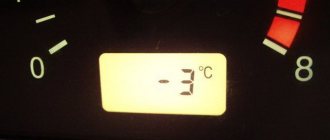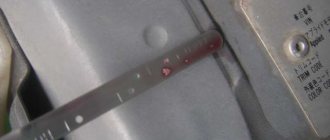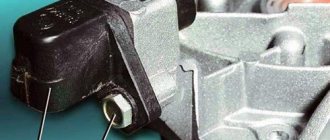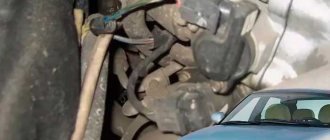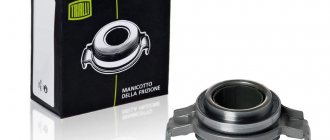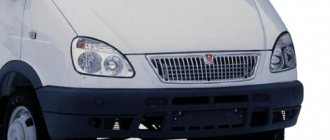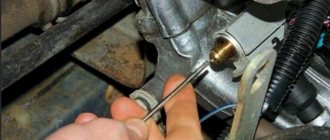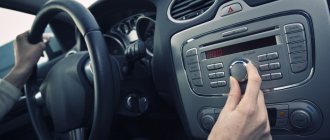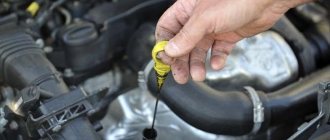The braking system is one of the main mechanisms in a car, responsible for reducing speed and stopping the vehicle. If a car does not go anywhere with a faulty engine, then if there is a problem with the brakes, movement becomes dangerous not only for the driver and passengers, but also for other road users. In this article we will look at the possible reasons for the brakes beating, which indicates some kind of malfunction.
The brake pedal hits when braking - these are extraneous vibrations going to the pedal at the moment of braking. There is a directly proportional relationship between pedal pushes and speed, that is, the higher the speed, the more intense the “response” to the pedal will be. If the speed is over one hundred kilometers per hour, with heavy braking, vibrations can also transfer to the steering wheel and car body.
Why does the brake pedal hit when braking?
Why does the brake pedal squeal when you press the brake? Most often, when various malfunctions are detected, motorists turn to a specialized service.
Do-it-yourself windshield polishing? See here for detailed instructions.
Do-it-yourself ignition switch illumination, more details in our article.
Do you need to replace your front suspension springs? You will find details in this article.
Yes, this is a common cause of “impacts” on the steering wheel or brake pedal, but there are still other malfunctions that give such a result. Let's consider what main malfunctions can cause such behavior of the car when the speed decreases.
- The first reason, which we have already described above, is deformation of the brake disc. Most often this happens due to severe overheating. The average operating temperature of a modern brake disc is 200-300 degrees. Overheated soft metal is prone to deformation, which causes irregularities to appear on the surface of the disk, which cause shocks. This problem can be solved by replacing the disks. If your driving style is quite aggressive, then you should consider purchasing brake discs that are more temperature-resistant. The ventilation of the disks, as well as their area, is responsible for heat resistance; the larger it is, the better the heat transfer.
- Wear of brake discs. With severe and uneven wear, scuffing may appear on the braking surface of the “pancake”, which will cause runout. Just a replacement solution. If the discs on one axle have uneven wear, it means that the braking of the right and left wheels occurs unevenly, which can also complicate driving and become a threat to life.
- Overheating of Ferodo coating on the pads. When the brake surface of the pads overheats, the friction linings simply begin to crumble, which is why they cannot properly and evenly press the brake disc and stop the wheel.
- Uneven or severe pad wear. Just like the surface of the disc, the braking surface of ferodo pads wears out over time. Wear may occur unevenly, which will affect the wear of the disc and the process of stopping the rotation of the wheel. Everything can be solved with a simple replacement. If the brake discs still have a sufficient layer of working surface and there are no defects, then you can only get by by replacing the pads as a pair on the axle. When installing new pads, be sure to clean the bracket, otherwise this may lead to the pad becoming sour over time. The pad must have free play in the bracket so that the caliper correctly presses its entire surface against the brake disc.
- Inoperative brake caliper cylinders. Another common problem is stuck pistons. This often happens due to torn boots of the brake pistons; because of this, dirt and moisture get into the brake cylinder, which “kills” the lubrication of the mechanism, which over time leads to souring and inoperability of the entire device. A caliper repair kit will help solve this problem. The kit will include a new boot, brake piston and lubricant. Everything is simple, you just need to “squeeze” the old piston out of the cylinder by pressing the brake pedal, then we clean everything, lubricate the cylinder walls, the piston and press it back, and install a new boot.
- Worn rear brake pads. Often noticeable only during heavy braking. Usually, in moderate driving mode, only the front mechanisms are involved in the braking process, the rear mechanisms are connected either later or during sharp braking. So if the beating does not occur with pressing the pedal, but later or towards the end, then this is most likely due to worn rear brake pads.
- Rear brake drums are worn or bent. When braking, the drum presses the pad unevenly or inconsistently, so there is no full contact between the pad and the braking surface, braking efficiency decreases and vibration is transmitted to the pedal or body. The reason for wear of these parts is most often their age, and the solution to this issue is simple - replacing worn out consumables with new ones.
- Severe wear on wheel bearings. Due to play and wear of the bearing working surface, vibration and hum are transmitted to the wheel. When braking, the front suspension of the car is loaded, which creates vibration from the bearing. It is possible to check bearing wear on a lift by checking the wheel for vertical play; if there is any, then the bearing has already “outlived” its usefulness and needs to be replaced.
Summarizing
The vibration of the brake pedal when braking is one of the symptoms of a malfunctioning brake system. The consequences can be very different from simple wear of parts to the creation of emergency situations due to brake failure.
For full operation of the brake system, full contact between the surface of the friction lining of the pad and the brake disc is necessary. If replacing worn parts helped only temporarily, maybe you should think about changing your driving style, because it is your driving style that affects the service life of the parts.
You should also not allow the temperature of heated elements (discs and calipers) to change; try to avoid puddles after braking, and also allow the brakes to cool before washing the car. To avoid breakdowns, you should visit service stations more often to check the performance and preventive maintenance of brake mechanisms, repair them in a timely manner, and also periodically inspect your brakes yourself.
You can test and find any faults in the brake system in your car on an empty section of the road, away from houses and pedestrians in order to avoid accidents.
First of all, you should carefully monitor the car’s braking process, listen to see if there are any extraneous noises or squeaks, whether the braking is uniform, or whether the direction of movement changes during sudden braking.
Probably one of the most serious troubles in a car is a malfunction of the brake system. And if the brake pedal hits when braking, you need to take immediate action. Indeed, in the event of an emergency, the car may not react to the press in time, and an accident will occur. The driver may become frightened by these beats and reduce the force of pressing the pedal. The only thing worse than this situation is a complete failure of the brake system. These vibrations on the pedals can also be accompanied by feedback to the steering wheel. Let's figure out where these vibrations come from, what can hit the pedal, and how to solve this problem.
How to check if the brake pedal is beating?
To do this, you need to go to a dry, uniform surface. Of course, it is best if it is asphalt. To complete the picture, you need to disable ABS. If this is not possible, then try to drive in such a way that the system practically does not interfere with the braking process.
Then they accelerate to 80 km/h. They try to brake sharply without the wheels being locked. If the brake pedal hits when braking, then you should think about diagnostics and repair. If there are large vibrations on the steering wheel while reducing speed, it is necessary to reduce the pressure on the pedal and stop the car smoothly.
Typical reasons
This system in cars has a fairly simple structure. There are not many components in it that could fail and cause vibrations. Moreover, every detail can be the source of a problem.
Thus, discs, drums, air getting into the lines, worn calipers and hubs can cause shaking. Sometimes the cause is worn tires. Often a crooked wheel can transmit vibration to the steering wheel, but there will be no vibration to the brake pedal.
Causes of vibrations during braking
This symptom often occurs even on new cars and the reasons may be different. This manifests itself in shocks, and, as a rule, they are stronger, the higher the speed at which the braking is carried out. If such vibrations occur, the reason is in the state of the final elements of the system.
Vibration can manifest itself in different ways:
- on the steering wheel;
- throughout the body;
- on the brake pedal.
In most cases, the origin of the problem lies in the brake discs or pads. But there are other options. Moreover, sometimes you have to go through a lot of probabilities before you can eliminate the problem. Main reasons:
- defective tires or wheels;
- unbalanced wheels;
- dirt;
- insufficient air pressure in tires;
- wear of chassis components;
- deformation of the hub itself;
- poorly tightened wheel bolts, etc.
The braking system is working properly, but there are vibrations
If, after checking all elements of the system, no serious damage or defects could be identified, then the problem may be hidden in non-obvious reasons. So, it could be:
- wheel imbalance;
- deformation of suspension arms;
- wheel bearing.
The reason may also be poor fastening of body elements and brake system parts. The car was driven on bad roads, and as a result, the brake pedal hits when braking. Niva is especially susceptible to these troubles. Perhaps a few bolts are not tightened somewhere, and the beating is felt on the pedal.
Wheel alignment
An incorrect wheel alignment angle can also create vibration that transfers from the wheel to the entire car body. When braking, the pedal directly receives a beat that is transmitted to it through the entire braking system.
When diagnosing the reason why the brake pedal hits when braking, factors indicating the need to check the wheel alignment are the following previous events:
- The car was in an accident, after which body repair work was carried out
- the suspension was repaired or, conversely, the suspension was not repaired for a long time
- the car received a blow to the wheels as a result of falling into a hole, quickly overcoming a speed bump, unsuccessful parking and hitting the curb.
Adjusting the wheel alignment angle must be done only on a fully serviceable suspension, the elements of which have not yet fully exhausted their service life.
Balance imbalance
Often, neither a tire nor a rim is ideal both in its shape and in terms of geometry characteristics. Since the weight in different parts is different, during the rotation of the wheel, the place where the mass is greater will pull the central part of the wheel along with it. This is how centrifugal force works. If the wheel rotates quickly and the car is traveling at high speed, then this force will turn into vibration. This is the reason why the brake pedal and steering wheel hit when braking.
If you drive on such wheels for a long time, the tire will wear unevenly, and this will lead to even greater vibrations. This also causes increased wear on car suspensions. The wheel bearing suffers the most from this.
The main symptom of imbalance is vibrations on the steering wheel. To diagnose this, the wheels are carefully inspected. If they are even, and the car did not drive through holes, then the problem lies precisely in the imbalance.
Warped tires or wheels
The cause of various vibrations can be crooked wheels. This is easy to identify on a balancing stand. More often, the wheel becomes deformed when it falls into a large hole. You can determine a crooked disk yourself. It is enough to visually inspect the wheel. Stamped discs are more susceptible to deformation.
A badly worn tire is also a common reason for the brake pedal to squeal when braking. The VAZ-2110 has a reliable design, but sometimes the cause of vibrations needs to be looked for here, rather than changing discs and pads. The cord on the tire may be damaged, causing part of it to become convex.
It is impossible to solve the problem without replacing the wheels. Most often they have to be replaced, especially when the damage is serious. There is an option to ride with them after balancing. However, the vibrations will take a very long time to disappear until the tread becomes uniform on one side and the other.
Brake disk
The first and most popular reason, according to experienced car enthusiasts and service station technicians, is damaged or crooked brake discs. Most often they bend due to sudden temperature changes. During intense braking, the surface of the disc becomes very hot.
If you drive into a puddle at this moment, the metal will cool sharply. As a result, the discs become deformed. Because of this, the brake pedal hits when braking. A complete replacement of the disks will help solve this problem. They change on two wheels at once.
Often the problem of vibrations is observed after repairs. This will take some time - new parts need time to break in.
No need to delay eliminating vibrations
Using a car with such symptoms is fraught with dire consequences. Due to vibrations, hub bearings, guides in calipers, and brake cylinders quickly wear out. Over time, you will have to change the steering rack and tips. And this is not the entire list.
Brake discs and drums can be machined. This will help return them to the desired shape. But we must remember that this is a last resort measure. If the disk thickness is minimal (less than 20 millimeters), only replacement will help. Otherwise, they will overheat even more. Don't skimp on spare parts. If a brake pad overheats, it is not a fact that it will not lose its properties. But often for this reason the brake pedal hits when braking. “Priora” is equipped with an anti-lock braking system “ABS”, and many owners say that it is the fault of the electronics that the pedal hits. But it’s better to check once again and identify defective parts.
Why does the brake pedal hit when braking?
The car's braking system is quite simple, and there are not many parts that can fail. Moreover, almost each of them can lead to the problem under consideration. If the brake pedal hits when braking, you need to check the following units:
- Brake pads. Severe wear on the brake pads can cause the brake pedal to squeal. It is necessary to check the pads for wear and determine their suitability. In this case, both front and rear pads should be diagnosed. If the thickness of the part does not meet the requirements of the brake system (or the pads have mechanical damage), it will need to be replaced. Do not forget that the pads must be changed in pairs on the same axis.
- Brake drum. When braking, the pads touch the drum. If it is damaged or deformed, vibration from their contact will be transmitted to the car body, including the brake pedal. Often the brake pads and brake drum on the rear axle of the car fail at the same time, and they will need to be replaced together to get rid of the problem.
- Brake discs. When operating a car, brake discs have to withstand severe loads associated not only with friction, but also with temperature changes. When driving in the city, you often need to press the brake pedal, which increases the temperature of the brake discs. If cold water (for example, snow) gets on them, they can become deformed under the influence of sudden temperature changes. A bent brake rotor will cause problems with braking and transmission of vibration into the pedal.
Please note: It is important to replace discs, like brake pads, in pairs on one axis. However, after replacing the disks, the problem may persist, even if all units are working properly. It is necessary to “break in” the new part a little so that the pads get used to it.
- Brake cylinders. If the brake cylinders are deformed or malfunctioning, this can cause the brake pedal to wobble. In such a situation, it is recommended to inspect the cylinders for any distortions. If they are not detected, you need to lubricate them to be sure that there are no freezes.
It is important to inspect the entire braking system when looking for the cause of brake runout. Due to one faulty unit, other parts may become unusable.
Front wheel brake system
In order to determine the culprit of the brake pedal beating, the braking system of the front wheels uses two complementary methods:
- Analysis of steering behavior during braking
- Handbrake braking
If, when braking, the beating is transmitted to the brake pedal and steering wheel at the same time and with the same frequency, then most likely there is a problem with the braking mechanism of the front wheels.
An indirect confirmation of this is the absence of vibration in the steering wheel when braking with the handbrake. In this case, slight vibration can be transmitted to the car body.
The reasons for the pedal beating, in this case, may be:
- wave-like curvature of the brake disc as a result of a sharp temperature change
- uneven rusting of the brake disc
- use of low-quality brake pads
- brake disc chip
- Excessive brake disc wear
- souring of brake cylinders
After a visual inspection of the brake mechanisms, it is necessary to replace the failed elements.
The brake hits when the braking system is working properly
If the braking system has been checked, but defective elements cannot be detected, the problem may be hidden in less obvious reasons. In such situations it is recommended:
- Make sure the wheels are properly balanced. An experienced driver can easily determine that the wheels of a car are unbalanced. A clear symptom of this is the rolling of the entire body when the car is moving, and not just the beating of the brake.
- Check the front suspension arms for bending and secure fastenings.
- Check the condition of the wheel bearing. If it becomes excessively worn, it will need to be replaced.
- Make sure that the fastening of body elements, suspension, and braking system is secure. Often the cause of brake chatter is poor bolt tightening throughout the vehicle. This problem is especially relevant when driving on bad roads. Check the tightness of all accessible bolts on the vehicle.
Rear wheel braking system
When diagnosing brake pedal beating, attention should be paid to the braking system of the rear wheels if there is no steering wheel beating when braking and vibrations are felt when braking with the hand brake.
There are 2 types of rear brake mechanisms on modern cars:
- drums
- disk
In the case of drum brakes, the cause of the brake pedal beating is the curvature of the drum when it takes on an elliptical shape. To eliminate this malfunction, it is necessary to replace the damaged elements of the brake system.
In the case of rear wheel disc brakes, the methods for diagnosing and repairing the breakdown are similar to those for front wheel disc brakes.
How to avoid car brakes from squealing
If the brake pedal begins to vibrate when pressed, then this problem will not go away on its own. It is necessary to diagnose the machine as soon as possible and eliminate the malfunction. To avoid such troubles in the future, you need to follow these recommendations:
- Monitor the brake fluid level in the reservoir;
- Regularly check the brake system for leaks;
- Change the pads on time, without waiting for their maximum wear.
The braking system is nothing to joke about, and at the first symptoms of its malfunction, the problem should be eliminated.
Design and principle of operation of the braking system
Diagram of the car brake system: 1 - brake disc; 2 — front wheel brake caliper; 3 - front contour; 4 - main cylinder; 5 — reservoir with brake fluid level sensor; 6 — vacuum brake booster; 7 — pusher; 8 — pedal; 9 — brake light switch; 10 — brake pads of the rear wheels; 11 — brake cylinder of the rear wheels; 12 - rear contour; 13 — rear axle axle housing; 14 — load spring; 15 — pressure regulator; 16 — rear cables; 17 — equalizer; 18 — front cable; 19 — parking brake handle; 20 — indicator of emergency drop in brake fluid level; 21 — parking brake warning switch; 22 — brake pads of the front wheels;
Before considering the reasons for the brake pedal beating, it is worth recalling how the braking system as a whole is designed. The simplest one consists of the following components:
- brake pedal;
- master brake cylinder;
- brake fluid reservoir;
- brake circuits (hoses, tubes);
- working brake cylinders.
This is a list of the main elements that make up a typical braking system. Modern cars, in addition to the specified parts, are also equipped with vacuum brake boosters and an ABS anti-lock braking system.
Conceptually, a car's braking system is a simple hydraulic system and operates on the same principle. When you press the pedal, muscle force is transferred to the master cylinder, which converts this mechanical energy into hydraulic energy. The pressure of the brake fluid in the brake circuits increases, and it acts on the working cylinders, which in turn press the pads against the brake discs and/or drums of all four wheels. As a result, the vehicle first slows down and then stops. As you can see, the principle of operation is simple.
